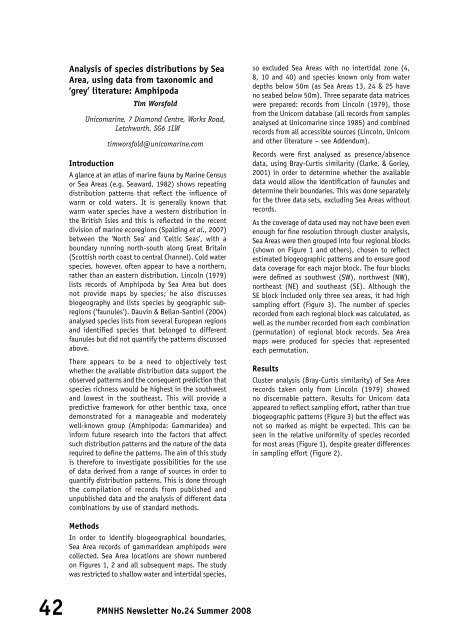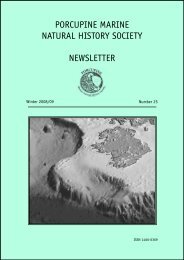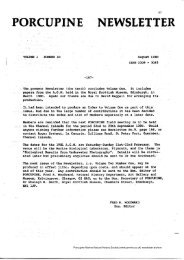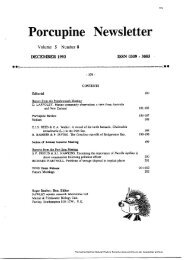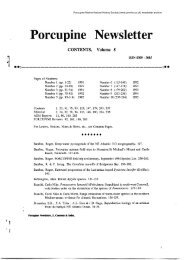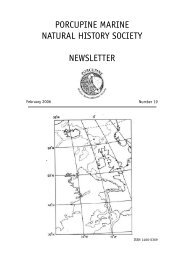PORCUPINE MARINE NATURAL HISTORY SOCIETY NEWSLETTER
PORCUPINE MARINE NATURAL HISTORY SOCIETY NEWSLETTER
PORCUPINE MARINE NATURAL HISTORY SOCIETY NEWSLETTER
You also want an ePaper? Increase the reach of your titles
YUMPU automatically turns print PDFs into web optimized ePapers that Google loves.
42<br />
Analysis of species distributions by Sea<br />
Area, using data from taxonomic and<br />
‘grey’ literature: Amphipoda<br />
Tim Worsfold<br />
Unicomarine, 7 Diamond Centre, Works Road,<br />
Letchworth. SG6 1LW<br />
timworsfold@unicomarine.com<br />
Introduction<br />
A glance at an atlas of marine fauna by Marine Census<br />
or Sea Areas (e.g. Seaward, 1982) shows repeating<br />
distribution patterns that reflect the influence of<br />
warm or cold waters. It is generally known that<br />
warm water species have a western distribution in<br />
the British Isles and this is reflected in the recent<br />
division of marine ecoregions (Spalding et al., 2007)<br />
between the ‘North Sea’ and ‘Celtic Seas’, with a<br />
boundary running north-south along Great Britain<br />
(Scottish north coast to central Channel). Cold water<br />
species, however, often appear to have a northern,<br />
rather than an eastern distribution. Lincoln (1979)<br />
lists records of Amphipoda by Sea Area but does<br />
not provide maps by species; he also discusses<br />
biogeography and lists species by geographic subregions<br />
(‘faunules’). Dauvin & Bellan-Santini (2004)<br />
analysed species lists from several European regions<br />
and identified species that belonged to different<br />
faunules but did not quantify the patterns discussed<br />
above.<br />
There appears to be a need to objectively test<br />
whether the available distribution data support the<br />
observed patterns and the consequent prediction that<br />
species richness would be highest in the southwest<br />
and lowest in the southeast. This will provide a<br />
predictive framework for other benthic taxa, once<br />
demonstrated for a manageable and moderately<br />
well-known group (Amphipoda: Gammaridea) and<br />
inform future research into the factors that affect<br />
such distribution patterns and the nature of the data<br />
required to define the patterns. The aim of this study<br />
is therefore to investigate possibilities for the use<br />
of data derived from a range of sources in order to<br />
quantify distribution patterns. This is done through<br />
the compilation of records from published and<br />
unpublished data and the analysis of different data<br />
combinations by use of standard methods.<br />
Methods<br />
In order to identify biogeographical boundaries,<br />
Sea Area records of gammaridean amphipods were<br />
collected. Sea Area locations are shown numbered<br />
on Figures 1, 2 and all subsequent maps. The study<br />
was restricted to shallow water and intertidal species,<br />
PMNHS Newsletter No.24 Summer 2008<br />
so excluded Sea Areas with no intertidal zone (4,<br />
8, 10 and 40) and species known only from water<br />
depths below 50m (as Sea Areas 13, 24 & 25 have<br />
no seabed below 50m). Three separate data matrices<br />
were prepared: records from Lincoln (1979), those<br />
from the Unicorn database (all records from samples<br />
analysed at Unicomarine since 1985) and combined<br />
records from all accessible sources (Lincoln, Unicorn<br />
and other literature – see Addendum).<br />
Records were first analysed as presence/absence<br />
data, using Bray-Curtis similarity (Clarke, & Gorley,<br />
2001) in order to determine whether the available<br />
data would allow the identification of faunules and<br />
determine their boundaries. This was done separately<br />
for the three data sets, excluding Sea Areas without<br />
records.<br />
As the coverage of data used may not have been even<br />
enough for fine resolution through cluster analysis,<br />
Sea Areas were then grouped into four regional blocks<br />
(shown on Figure 1 and others), chosen to reflect<br />
estimated biogeographic patterns and to ensure good<br />
data coverage for each major block. The four blocks<br />
were defined as southwest (SW), northwest (NW),<br />
northeast (NE) and southeast (SE). Although the<br />
SE block included only three sea areas, it had high<br />
sampling effort (Figure 3). The number of species<br />
recorded from each regional block was calculated, as<br />
well as the number recorded from each combination<br />
(permutation) of regional block records. Sea Area<br />
maps were produced for species that represented<br />
each permutation.<br />
Results<br />
Cluster analysis (Bray-Curtis similarity) of Sea Area<br />
records taken only from Lincoln (1979) showed<br />
no discernable pattern. Results for Unicorn data<br />
appeared to reflect sampling effort, rather than true<br />
biogeographic patterns (Figure 3) but the effect was<br />
not so marked as might be expected. This can be<br />
seen in the relative uniformity of species recorded<br />
for most areas (Figure 1), despite greater differences<br />
in sampling effort (Figure 2).


